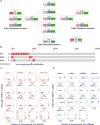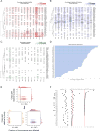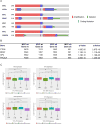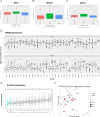Pan-cancer Alterations of the MYC Oncogene and Its Proximal Network across the Cancer Genome Atlas
- PMID: 29596783
- PMCID: PMC5892207
- DOI: 10.1016/j.cels.2018.03.003
Pan-cancer Alterations of the MYC Oncogene and Its Proximal Network across the Cancer Genome Atlas
Abstract
Although the MYC oncogene has been implicated in cancer, a systematic assessment of alterations of MYC, related transcription factors, and co-regulatory proteins, forming the proximal MYC network (PMN), across human cancers is lacking. Using computational approaches, we define genomic and proteomic features associated with MYC and the PMN across the 33 cancers of The Cancer Genome Atlas. Pan-cancer, 28% of all samples had at least one of the MYC paralogs amplified. In contrast, the MYC antagonists MGA and MNT were the most frequently mutated or deleted members, proposing a role as tumor suppressors. MYC alterations were mutually exclusive with PIK3CA, PTEN, APC, or BRAF alterations, suggesting that MYC is a distinct oncogenic driver. Expression analysis revealed MYC-associated pathways in tumor subtypes, such as immune response and growth factor signaling; chromatin, translation, and DNA replication/repair were conserved pan-cancer. This analysis reveals insights into MYC biology and is a reference for biomarkers and therapeutics for cancers with alterations of MYC or the PMN.
Keywords: MAX; MNT; MYC genomic alterations; TCGA; The Cancer Genome Atlas.
Copyright © 2018 The Authors. Published by Elsevier Inc. All rights reserved.
Figures







References
-
- Adhikary S, Marinoni F, Hock A, Hulleman E, Popov N, Beier R, Bernard S, Quarto M, Capra M, Goettig S, et al. The ubiquitin ligase HectH9 regulates transcriptional activation by Myc and is essential for tumor cell proliferation. Cell. 2005;123:409–421. - PubMed
-
- Ayer DE, Kretzner L, Eisenman RN. Mad: a heterodimeric partner for Max that antagonizes Myc transcriptional activity. Cell. 1993;72:211–222. - PubMed
-
- Bahram F, von der Lehr N, Cetinkaya C, Larsson LG. c-Myc hot spot mutations in lymphomas result in inefficient ubiquitination and decreased proteasome-mediated turnover. Blood. 2000;95:2104–2110. - PubMed
-
- Bartel DP. MicroRNAs: genomics, biogenesis, mechanism, and function. Cell. 2004;116:281–297. - PubMed
-
- Bazarov AV, Adachi S, Li SF, Mateyak MK, Wei S, Sedivy JM. A modest reduction in c-myc expression has minimal effects on cell growth and apoptosis but dramatically reduces susceptibility to Ras and Raf transformation. Cancer Res. 2001;61:1178–1186. - PubMed
Publication types
MeSH terms
Substances
Grants and funding
- P30 CA016672/CA/NCI NIH HHS/United States
- U24 CA143882/CA/NCI NIH HHS/United States
- U24 CA143840/CA/NCI NIH HHS/United States
- R01 CA214428/CA/NCI NIH HHS/United States
- U54 HG003273/HG/NHGRI NIH HHS/United States
- U24 CA143843/CA/NCI NIH HHS/United States
- U24 CA143848/CA/NCI NIH HHS/United States
- U01 CA176303/CA/NCI NIH HHS/United States
- U24 CA210957/CA/NCI NIH HHS/United States
- U24 CA210949/CA/NCI NIH HHS/United States
- U54 HG003079/HG/NHGRI NIH HHS/United States
- R50 CA221675/CA/NCI NIH HHS/United States
- U24 CA210990/CA/NCI NIH HHS/United States
- U54 HG003067/HG/NHGRI NIH HHS/United States
- U24 CA143835/CA/NCI NIH HHS/United States
- R01 CA057138/CA/NCI NIH HHS/United States
- U24 CA143866/CA/NCI NIH HHS/United States
- U24 CA210950/CA/NCI NIH HHS/United States
- U24 CA143845/CA/NCI NIH HHS/United States
- U24 CA143799/CA/NCI NIH HHS/United States
- P30 CA008748/CA/NCI NIH HHS/United States
- U24 CA144025/CA/NCI NIH HHS/United States
- U24 CA143858/CA/NCI NIH HHS/United States
- U24 CA143883/CA/NCI NIH HHS/United States
- R01 CA163722/CA/NCI NIH HHS/United States
- U01 CA217883/CA/NCI NIH HHS/United States
- U24 CA143867/CA/NCI NIH HHS/United States
- R01 CA149707/CA/NCI NIH HHS/United States
LinkOut - more resources
Full Text Sources
Other Literature Sources
Research Materials
Miscellaneous

